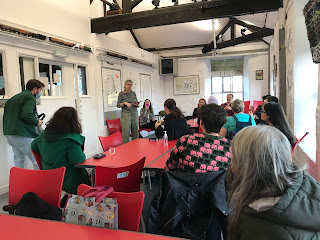By Gill Crawshaw
George Thompson worked at Gotts Mill, now Leeds Industrial Museum at Armley Mills in Yorkshire, UK, in the 1840s. George’s job was as a handle-setter, putting teasels into metal frames which were fitted onto a teasel-raising gig. This machine was used in the finishing stages of cloth making, there’s an example of one in the Industrial

The Leeds Industrial Museum at Armley Mills
Source: https://en.m.wikipedia.org/wiki/Leeds_Industrial_Museum_at_Armley_Mills
George was a young man who lived near the mill in Armley. Jobs preparing teasels for cloth-finishing were usually done by young men and boys, and perhaps George had started work as a preemer, sorting and cleaning the teasels. His boss reported that George “acquired the business equally fast, and as well as others” and reckoned that “when he is of age he will be able to earn as good wages as any other men in the same employment”.
How do we know this about George and why did his boss make these remarks?
In the 1840s and 1850s, the Yorkshire Institute for the Deaf and Dumb (now Doncaster School for the Deaf) sent a survey out to employers and families of former pupils of the school. The responses formed a series of reports (YIDD 1844,
I’m an independent disabled curator and I’ve been researching the lives of people like George, to show that Deaf and disabled people are part of our history and contributed to society. Disabled people are often portrayed as dependent or as burdens, in the past as well as today. And a common assertion in disability studies is that industrialisation excluded disabled people from work (Barnes 1991; Finkelstein 1981).
I've focused on disabled people who worked in textile mills, from the Industrial Revolution onwards. I became interested in this topic when I organised an exhibition called Shoddy a few years ago. Shoddy showed textile-based artworks by disabled artists. As well as looking back at the textile industry, the exhibition commented on contemporary society’s often shoddy treatment of disabled people, with cuts to benefits and public services.
I shared some of my research with a group of disabled people at an event at Armley Mills Industrial Museum in November 2021. This event was part of Leeds Museums and Galleries’ 200th birthday celebrations, and also fell within ;UK Disability History Month. Thanks to all the museum staff who supported this event. Being in the surroundings of the mill, with its large collection of textile machinery, set the scene for thinking about life for disabled mill workers and the harsh and hazardous conditions they faced.
They had little choice, they would have wanted to avoid the even harsher conditions of the
One example was William Dodd, who described himself as a ‘factory cripple’ in his account of his working life (1841). He mentions other disabled people who worked in the mills. Dodd tried to get other jobs, but they didn’t work out and he was dismissed. Still, he didn’t go to the workhouse, but returned, as a disabled person, to the wool
Dodd started out as a piecer, but after he realised he would be working in the mills long-term, he managed to get a slightly better job, ‘where the labour was not so very distressing, but the care and responsibility was greater; and although I was a complete cripple, I now began to feel a little more comfortable.’ (Dodd, 1841: 16).
Workers didn’t just accept the terrible conditions passively. In the 18th and 19th centuries workers started to come together to resolve issues at
One of the most striking features of textile mills was the great din produced by rows of spinning mules, power looms and other machinery. The noise made by a single spinning mule at Armley Industrial Museum gave some idea of what it would have been
Janet Alexander, a Deaf theatre professional and actor, skil
Taking the limited information about Sarah, along with general knowledge about mill workers’ lives, plus her specific knowledge and understanding of the history of Deaf people in Leeds, Janet created a rounded and relatable character.
Sarah was described by her boss as a good learner with ‘proper’ conduct. However, he wrote that ‘She is not quite so even-tempered as other girls in the same employment.’ (YIDD 1844-1859). Janet gave us a real insight into the life of Sarah, a spirited, proud young Deaf woman.
Vickie Orton, a disabled textile artist and storyteller, drew on her family history to tell us the more recent account of her great aunt Gladys who worked in a mill
In the past as today, disabled people want to work, to be independent and to be part of the community, although the world of work is not always supportive of disabled people. In discussions at the end of the November
_____________________
References:
Barnes, Colin. 1991. Disabled People in Britain & Discrimination, p62. London: Hurst & Co.
Dodd William. 1841. A Narrative of the Experience and Sufferings of William Dodd a Factory Cripple. London: L&G Seeley.
Finkelstein, Vic. 1981. ‘Disability and the helper/helped relationship. An historical view’ in Brechin, A., Liddiard, P. and Swain, J. (eds) Handicap in a social world. London: Hodder and Stoughton.
Sadler, Michael. 1832. Report of the Select Committee on Factory Children's Labour. Parliamentary Papers 1831-32, volume XV.
Turner, David and Blackie, Daniel. 2018. Disability in the Industrial Revolution: Physical Impairment in British Coalmining, 1780–1880. Manchester: Manchester University Press.
Yorkshire Institute for the Deaf and Dumb. 1844, reprinted 1859. Results of an inquiry respecting the former pupils of the former pupils of the Yorkshire Institution for the deaf and dumb. Doncaster: Yorkshire Institute for the Deaf and Dumb.
Crawshaw, Gill (2022): Hidden histories of disabled mill workers.In: Public Disability History 7 (2022) 1.



